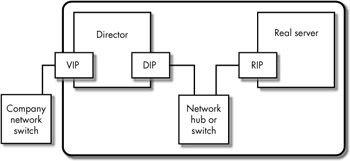LVS IP Address Name Conventions
In an LVS cluster, we cannot refer to network addresses as simply "IP addresses." Instead, we must distinguish between different types of IP addresses based on the roles of the nodes inside the cluster. Here are four basic types of IP addresses used in a cluster:
Virtual IP (VIP) address
-
The IP address the Director uses to offer services to client computers
Real IP (RIP) address
-
The IP address used on the cluster nodes
Director's IP (DIP) address
-
The IP address the Director uses to connect to the D/RIP network
Client computer's IP (CIP) address
The IP address assigned to a client computer that it uses as a source IP address for requests sent to the cluster
The Virtual IP (VIP)
The IP address that client computers use to connect to the services offered by the cluster are called virtual IP addresses (VIPs). VIPs are IP aliases or secondary IP addresses on the NIC that connects the Director to the normal, public network.[1] The LVS VIP is important because it is the address that client computers will use when they connect to the cluster. Client computers send packets from their IP address to the VIP address to access cluster services. You tell the client computers the VIP address using a naming service (such as DNS, DDNS, WINS, LDAP, or NIS), and this is the only name or address that client computers ever need to know in order to use the services inside the cluster. (The remaining IP addresses inside the cluster are not known to the client computer.)
A single Director can have multiple VIPs offering different services to client computers, and the VIPs can be public IP addresses that can be routed on the Internet, though this is not required. What is required, however, is that the client computers be able to access the VIP or VIPs of the cluster. (As we'll see later, an LVS-NAT cluster can use a private intranet IP address for the nodes inside the cluster, even though the VIP on the Director is a public Internet IP address.)
The Real IP (RIP)
In LVS terms, a node offering services to the outside world is called a real server. (We will use the terms cluster node and real server interchangeably throughout this book.) The IP address used on the real server is therefore called a real IP address (RIP).
The RIP address is the IP address that is permanently assigned to the NIC that connects the real server to the same network as the Director. We'll call this network cluster network or the Director/real-server network (D/RIP network). The Director uses the RIP address for normal network communication with the real servers on the D/RIP network, but only the Director needs to know how to talk to this IP address.
The Director's IP (DIP)
The Director's IP (DIP) address is used on the NIC that connects the Director to the D/RIP network. As requests for cluster services are received on the Director's VIP, they are forwarded out the DIP to reach a cluster node. As is discussed in Chapter 15, the DIP and the VIP can be on the same NIC.
The Client Computer's IP (CIP)
The client computer's IP (CIP) address may be a local, private IP address on the same network as the VIP, or it may be a public IP address on the Internet.
IP Addresses in an LVS Cluster
A schematic of an LVS cluster containing one cluster node (one real server) and one Director is shown in Figure 11-1.

Figure 11-1: LVS cluster schematic
In this figure, the Director's public NIC, using the VIP address, is connected to the company network switch, or this could be an Internet router. The NIC connected to the D/RIP network has the DIP address on it. Figure 11-1 shows a D/RIP network hub or switch, though as we'll see, some cluster configurations can use the same network switch for both the public NIC and the cluster NIC (in LVS-DR clusters). Finally, the NIC that connects the real server to the D/RIP network is shown with a RIP address. Incoming packets destined for the real server arrive on the VIP, pass through the Director and out its DIP, and finally reach the real server's RIP.
[1]As you'll see in Chapter 15, the VIPs in a high-availability configuration are under Heartbeat's control.
EAN: 2147483647
Pages: 219